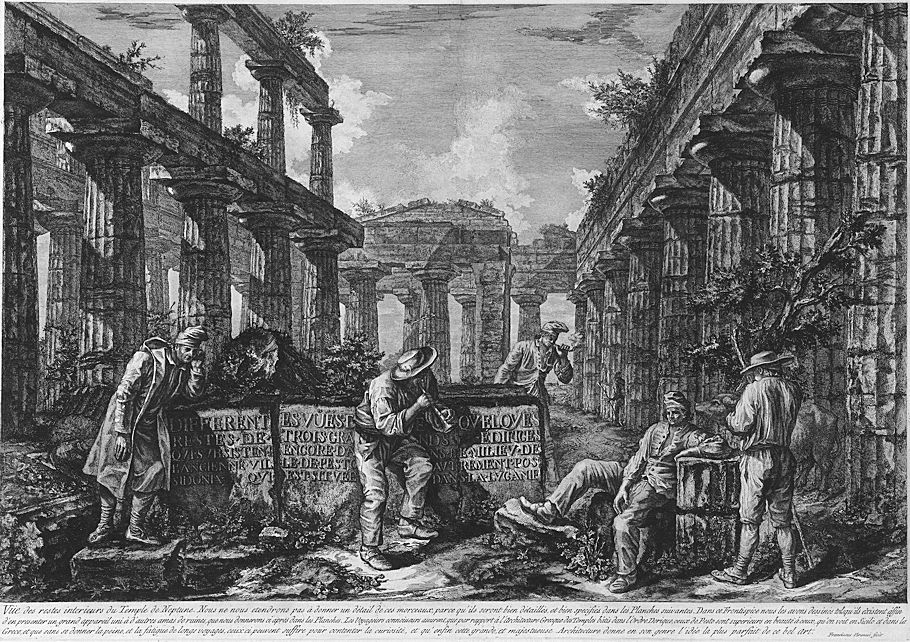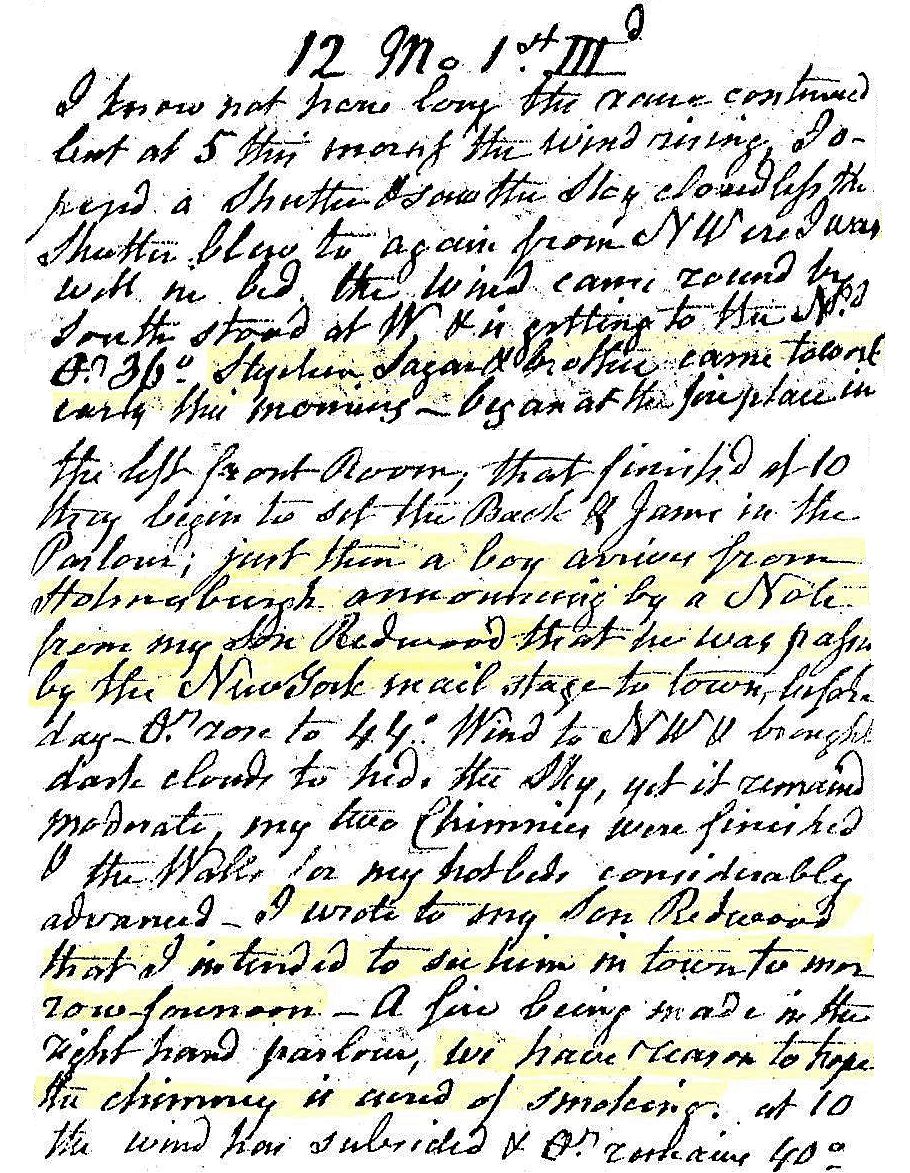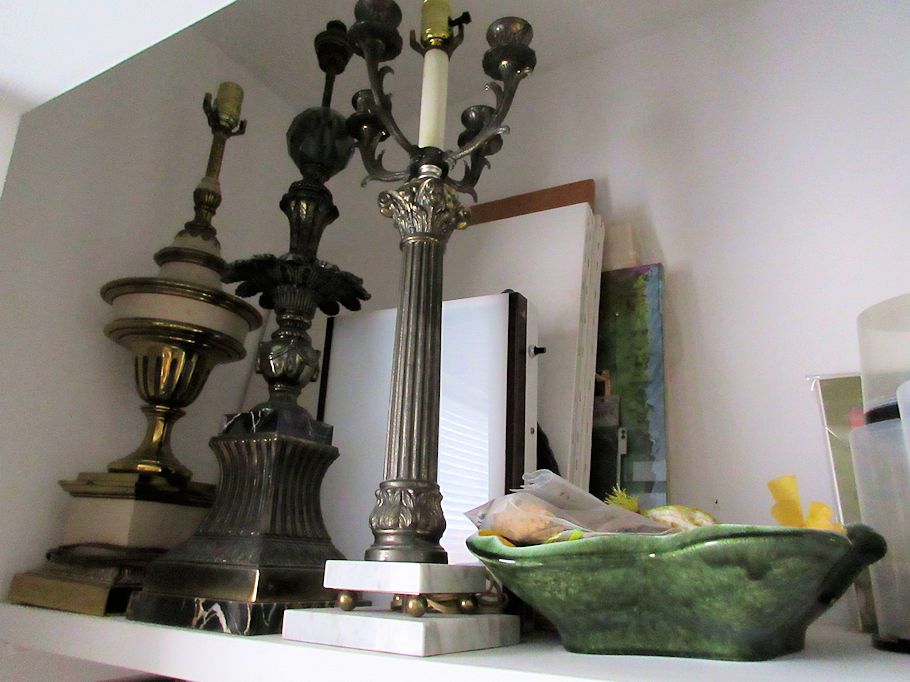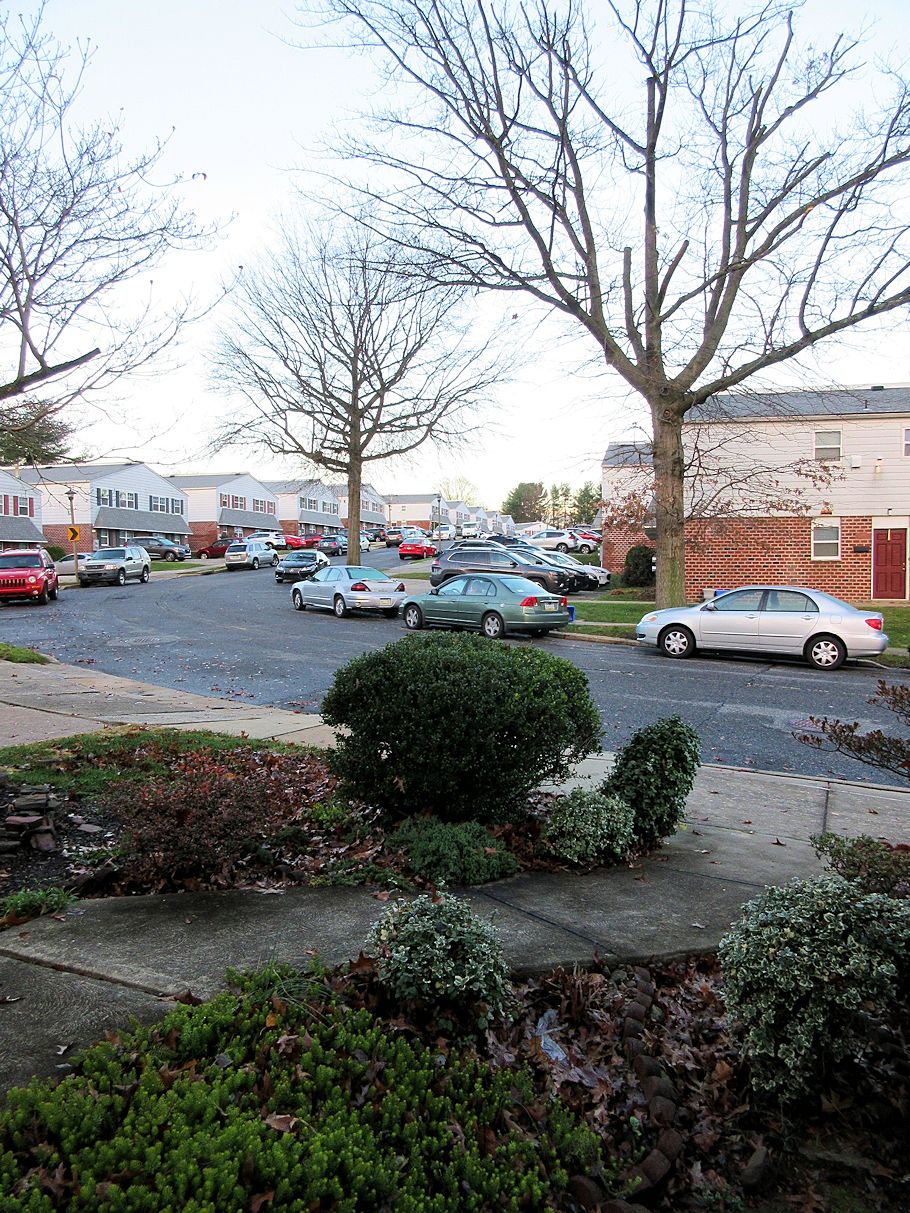1 December 1778 Tuesday

Vüe des restes interieurs du Temple de Neptune. Nous ne nous etendrons pas à donner un détail de ces morceaux, parce qu'ils seront bien détaillés, et bien specifiés dans les Planches suivantes. Dans ce Frontispice nous les avons dessinés telsqu'ils éx istent áf fin d'en presenter un grand appareil uni à d'autres amas de ruines, que nous donnerons ci apres dans les Planches. Les Voyageurs connoisseurs assurent, que par rapport á l'Architecture Grecque des Temples bâtis dans l'Ordre Dorique, ceux de Pesto sont superieurs en beautè á ceux, qu'on voit en Sicilè et dans la Grece, et que sans se donner la peine, et la fatigue de longs voyages, ceux ci peuvent suffire pour contenter la curiositè, et qu'enfin cette grande, et majestueuse Architecture donne en son genre l'idée la plus parfait de ce bel Art. Franciscus Piranesi fecit
View of the interior remains of the Temple of Neptune. We will not extend to give a detail of these pieces, because they will be well detailed, and well specified in the following Plates. In this Frontispiece we have drawn them as they exist in order to present a large apparatus united with other piles of ruins, which we will give hereafter in the Plates. Knowledgable Travelers assert that, compared to the Greek Architecture of the Temples built in the Doric Order, those of Pesto are superior in beauty to those seen in Sicily and Greece, and that without taking the trouble, and the fatigue of long journeys, these may suffice to satisfy the curiosity, and that finally this great, and majestic Architecture gives in its kind the most perfect idea of this beautiful Art.
1 December 1812 Tuesday

I know not how long the rain continued, but at 5 this morning the wind rising I opened a shutter and saw the sky cloudless. The shutter blew to again from NW. As I was well in bed, the wind came round by south, stood at W and is getting to N. Temperature 36 degrees. Stephen Sagen and brother came to work early this morning--began at the fireplace in the left front room, that finished at 10, they began to set the back and j... in the parlour. Just then a boy arrived from Holmesburg announcing by a note from my son Redwood that he was passing by the New York mail stage to town. ......day temperature rose to 44 degrees. Wind to NE and brought dark clouds to hide the sky, yet it remained moderate. My two chimneys were finished and the wall for my hot beds were considerably advanced. I wrote to my son Redwood that I intend to see him in town tomorrow forenoon. I fire being made in the right hand parlour, we have reason to hope the chimney is cured of smoking. At 10 the wind has subsided and temperature rose ... 40 degrees.
1971
In the late eighteenth century, a new configuration was to appear that would definitively blur the old space of natural history for modem eyes. On the one hand, we see criticism displacing itself and detaching itself from the ground where it had first arisen. Whereas Hume made the problem of causality one case in the general interrogation of resem-blances, Kant, by isolating causality, reverses the question; whereas before it was a question of establishing relations of identity or difference against the continuous background of similitudes, Kant brings into prominence the inverse problem of the synthesis of the diverse. This simultaneously transfers the critical question from the concept to the judgement, from the existence of the genus (obtained by the analysis of representations) to the possibility of linking representations together, from the right to name to the basis for attribution, from nominal articula-tion to the proposition itself, and to the verb to be that establishes it. Whereupon it becomes absolutely generalized. Instead of having validity solely when applied to the relations of nature and human nature, it questions the very possibility of all knowledge.
On the other hand, however, and during the same period, life assumes its autonomy in relation to the concepts of classification. It escapes from that critical relation which, in the eighteenth century, was constitutive of the knowledge of nature. It escapes - which means two things: life becomes one object of knowledge among others, and is answerable, in this respect, to all criticism in general; but it also resists this critical jurisdiction, which it takes over on its own account and brings to bear, in its own name, on all possible knowledge. So that throughout the nine-teenth century, from Kant to Dilthey and to Bergson, critical forms of thought and philosophies of life find themselves in a position of reciprocal borrowing and contestation.
Michel Foucault, The Order of Things: An Archaeology of the Human Sciences (1971), p. 162.
This event, probably because we are still caught inside it, is largely beyond our comprehension. Its scope, the depth of the strata it has affected, all the positivities it has succeeded in disintegrating and recomposing, the sovereign power that has enabled it, in only a few years, to traverse the entire space of our culture, all this could be appraised and measured only after a quasi-infinite investigation concerned with nothing more nor less than the very being of our modernity. The constitution of so many positive sciences, the appearance of literature, the folding back of philosophy upon its own development, the emergence of history as both knowledge and the mode of being of empiricity, are only so many signs of a deeper rupture. Signs scattered through the space of knowledge, since they allow themselves to be perceived in the formation, here of philology, there of economics, there again of biology. They are chrono-logically scattered too: true, the phenomenon as a whole can be situated between easily assignable dates (the outer limits are the years 1775 and 1825); but in each of the domains studied we can perceive two successive phases, which are articulated one upon
the other more or less around the years 1795-1800. In the first of these phases, the fundamental mode of being of the positivities does not change; men's riches, the species of nature, and the words with which languages are peopled, still remain what they were in the Classical age: double representations-representations whose role is to designate representations, to analyse them, to compose and decompose them in order to bring
into being within them, together with the system of their identities and differences, the general principle of an order. It is only in the second phase that words, classes, and wealth will acquire a mode of being no longer compatible with that of repre-sentation. On the other hand, what is modified very early on, beginning with the analyses of Adam Smith, A-L. de Jussieu, or Vicq d'Azyr, at the time of Jones or Anquetil-Duperron, is the configuration of positivi-ties: the way in which, within each one, the representative elements function in relation to one another, in which they perform their double role as designation and articulation, in which they succeed, ,by means of the interplay of comparisons, in establishing an order.
Michel Foucault, The Order of Things: An Archaeology of the Human Sciences (1971), p. 221.
1 December 1998
Alexander Severus
a Roman emperor, A.D. 222-235.
Alexander Severus is one of four Roman emperors from the third century associated with buildings and specific sites delineated within the Ichnographia Campus Martius. Caracalla, Geta, and Gordian III are the other third century emperors named in the Ichnographia, however the number of building attributions apropos Alexander Severus substantially outnumber those of these emperors, and, Alexander Severus is indeed second only to the emperor Nero in the number of structures and places within the Ichnographia that bear his name. It is historically true that ample building activity in the Campus Martius occurred during Alexander Severus' reign, and, with one notable exception, Piranesi positions the Alexander Servian constructions with acceptable correctness within his large plan -- the placement of the Thermae Alexandri Severi, Nemus Alexandri Severi, and the Aqua Alexandrina (the Baths, Grove, and Aqueduct of Alexander Severus respectively) in the area west of the Thermae Agrippa and nearby the Thermae Neronianae coincides with corresponding verifiable archeological locations. Piranesi's positioning of the Porticus Alexandri Severi, on the other hand, at the end of the Equiria, far to the north of the Campus Martius, deviates grossly from its traditional location near the Saepta Julia.
The only questionable building that Piranesi attributes to Alexander Severus within the Ichnographia, which may or may not have actually been within the Campus Martius, is the Domus Alexandri Severi.
Cochlearum Hirpini
coclearium : an enclosure or pen in which snails were kept and fed
Hirpini : a people of Lower Italy, between Campania, Lucnia, and Apulia
Positioned at the northern-most end of the Equiria, the Cochlearum Hirpini forms a symmetrical building composition together with the Vivaria Fulvii. This pen for storing and feeding snails has no historical or archeological substantiality, nor does it play any direct role in the Equiria's general horse-race or military theme. Even the name Hirpini offers no substantial clue as to the possible reason that Piranesi placed such a building at this location.
On purely literal terms, there is a connection between the word cochlea--spiral--and the Naumachia Domitiani's spiral formation. Otherwise, Piranesi may be making some kind of "inverted" joke regarding the swiftness of the Equirian horse-races and the slowness of snails.
Equiria
According to Festus, it was Romulus who instituted the first horse-races in honor of Mars. These races became an annual event, and, due to their origin, are rightly considered the "proto" festival or feast of Roman tradition. According to Varro, the races took on the name of Equirria, which is derived "from the equorum cursus 'running of horses'; for on that day they 'run' races in the sports on the Campus Martius." Furthermore, Ovid's Fasti lists the dates of the races as the 27th of February and the 14th of March, and, since the Roman calendar began the 1st of March, the holding of the first horse-race the day just before the new year further attests the Equirria's premire "fest" position.
1 December 2016

1 December 2020

1 December 2022 Thursday
One could say that Francesco's individual career commenced with the publication of Différentes vues de quelques Restes de trois grands Edifices qui subsistent encore dans le milieu de l'ancienne Ville de Pesto autrement Posidinia qui est située dans la Lucanie.
|